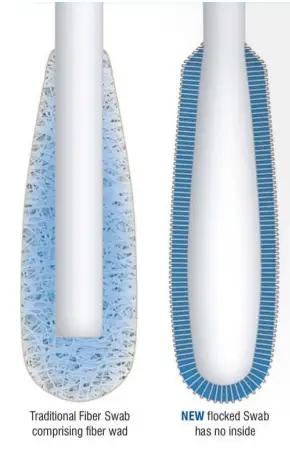News and Blogs
How Flocked Swabs Collect and Release Specimens?
Since the COVID-19 pandemic, the demand for nasopharyngeal and oropharyngeal swabs has increased in the IVD industry as rapid diagnostic tests have become more common. The quality of swabs on the market varies. On the other hand, there is a growing demand for higher-quality swabs. This paradox has given rise to a question that people are eager to understand: what kind of swab is better?
It is a big proposition that needs to be considered from various aspects. Here we will cut through the collection and release of samples by flocked swabs so that you can understand why flocked swabs are a good choice in the IVD industry.
Contents
- 1. What is a flocked swab?
- 2. How to use flocked swabs to collect and release specimens?
- 3. The full-length size range
- 4. Quick and easy handling and transportation
1. What is a flocked swab?
"Flocking" is a process in which short monofilament fibers are fixed vertically to a substrate previously coated with an adhesive. The substrate can be glass, metal, plastic, paper, or textile. Static electricity holds the short nylon fibers upright when we produce flocked swabs. Then they are applied to the surface of a medical ABS plastic rod.
The following diagram shows the structure of a flocked swab and a traditional wrapped swab:

2. How to use flocked swabs to collect and release specimens?
Flocked swabs are used in the same manner as traditional swabs:
1. Tear open the sterile pouch containing the swab.
2. Take out the swab and collect the sample at the corresponding site of the tested person, according to the usage instruction.
3. Place the sampled swab in a sterile tube with transport medium liquid and transfer it to the laboratory for microbiological analysis.
In the second step of the process, the flocked swabs have a larger surface area than conventional swabs due to their brush-like tip, which provides a good collection relative to traditional swabs(e.g., cotton swabs). The capillary action generated by the surface tension between the nylon fiber bundles will facilitate the sample's absorption.
In the third step of the process, as seen in the figure above, unlike wrapped swabs, flocked swabs do not have an inner core that binds the collected sample. Thus the sample can be fully released into the liquid medium.
Studies have shown that this improved design increases the swab's specimen collection and release rate. The increased number of cells in the target sample compared to non-flocked swabs helps improve the sensitivity and positive detection rate of the rapid diagnostic test.
3. The full-length size range
Mantacc is not the only medical product supplier that offers flocked swabs. However, we are the only company that supplies full-size, multi-length flocked swabs appropriate for sampling sites covering the oral, cervical, anal, anterior, and posterior nasal cavities. Mantacc flocked swabs are manufactured using specialized electrostatic equipment to absorb and extract more samples than traditional cotton, polyester, or rayon swabs.
4. Quick and easy handling and transportation
Our flocked swabs have pre-molded breakpoints, which allow the tester to easily snapped off at the appropriate length to fit in a transport tube. The swabs are sterile and fit both dry and media-filled transport tubes. The transport is also easy and trouble-free by replacing the top portion of the tube after sampling. Click on the image below to request a sample, or contact us for more information.
Find Products: Flocked Swabs, Test Kits
References
1. Mokomane M, Kasvosve I, Gaseitsiwe S, Steenhoff AP, Pernica JM, Lechiile K, Luinstra K, Smieja M, Goldfarb DM. A comparison of flocked swabs and traditional swabs, using multiplex real-time PCR for detection of common gastroenteritis pathogens in Botswana. Diagn Microbiol Infect Dis. 2016 Oct;86(2):141-3. [PMC ARTICLE]
2. Zasada AA, Zacharczuk K, Woźnica K, Główka M, Ziółkowski R, Malinowska E. The influence of a swab type on the results of point-of-care tests. AMB Express. 2020 Mar 12;10(1):46. [PMC ARTICLE]
Related Posts
Nasopharyngeal Flocked Swabs: An Optimal Method for Respiratory Virus Detection
Improved Detection of Anal hHSIL with Nylon-Flocked Swab
How Flocked Swabs Collect and Release Specimens?







